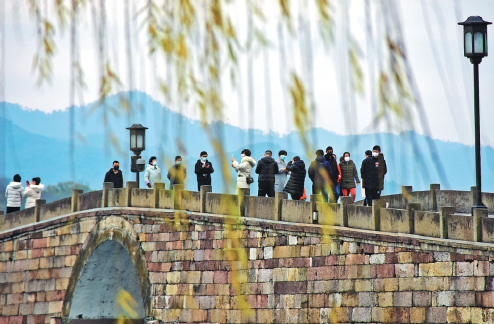
People visit the West Lake scenic area in Zhejiang province's Hangzhou. Some scenic spots in the country have reopened. (Photo: Xinhua)
The novel coronavirus epidemic has been largely contained in China, with most of the new cases being those who came in close contact with the infected or people coming from abroad. But despite the positive signs, local governments should think twice about lowering their public health emergency response level by lifting restrictions on public transport or allowing enterprises to resume production.
A number of tourist spots that re-opened have seen an onrush of visitors, spreading confusion and speculation over the epidemic.
People should therefore be reminded that the epidemic has not been fully contained, the many positive signs notwithstanding. That people showing no signs of being infected but carrying the virus could transmit it to others and the newly infected people could exhibit the symptoms after weeks highlights the necessity of people avoiding crowded places or coming in close contact with other people for as long as possible.
As for tourist spots, they should not rush to re-open their facilities to make profit by putting people's health in danger. Scenic spots with rooftops and closed buildings should refrain from re-opening anytime soon since the novel coronavirus spreads faster in closed environments. And natural scenic spots should place a cap on the number of visitors, by introducing online bookings.
Also, the staff at the ticket counters of tourist spots should manage the queues to ensure that the visitors keep a distance of more than 1.5 meters between them. Scenic spots should admit only a certain number of tourists to make sure there is enough space between them on tourist vehicles within the sites.
Tourists on their part should show their identity cards and register with their real names at tourists spots to help track and contain the spread of the virus, in case of an infection being reported.
In this regard, Zhejiang province has set a good example by issuing a "health code certificate" to those no longer under medical observation or not needing quarantine to enable them to visit public places. This health code system should be used by other places, too, to help manage and facilitate the flow of visitors at tourist sites.
Besides, tourist centers should inform the visitors about the epidemic prevention and control policy, and implementation procedures and requirements by putting up notices on bulletin boards at vantage points. Such notices should also be prominently displayed on the online booking sites of tourist spots.
Further, public spaces including parking lots and public toilets, and dustbins should be disinfected daily. While the electric touch screen, audio tour guide equipment and entertainment programs that involve close contact should be suspended or disinfected after it is used by a person, closed public spaces should be either closed or well ventilated, and dining spaces and canteens inside tourist spots shifted to open spaces with enough distance between diners.
Most important, visitors should be allowed to enter tourist spots only if they are wearing face masks. That is to say, the tourist sites better store protective medical gear for visitors who may need them if they drop or soil the masks or gloves they are wearing.
In other words, the tourist spots should take all health safety measures before re-opening their facilities, because public health, under no circumstances, should be compromised.
The author is executive deputy dean of the Public Policy Research Institute of Renmin University of China. The views don't necessarily represent those of China Daily.


